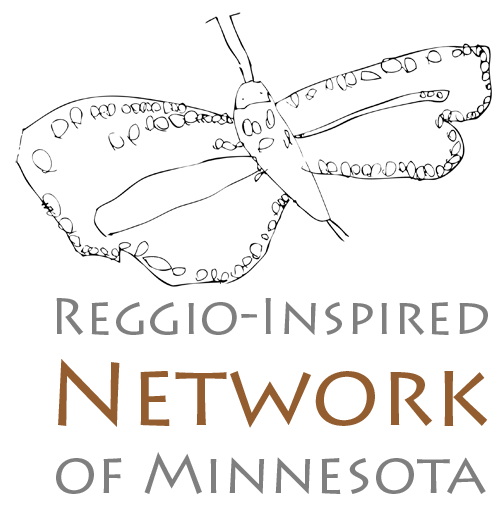|
|
“Learning and teaching should not stand on opposite banks and just watch the river flow by; instead, they should embark together on a journey down the water. Through an active reciprocal exchange, teaching can strengthen learning how to learn.” -Loris Malaguzzi | The Seeing Children Project
The Network initiative, “Seeing Children,” began as preparations were being made to host the "Hundred Languages of Children" exhibit from Reggio Emilia in St. Paul, MN in 2004. Network members wanted to make visible the work of the Minnesota community, with its unique culture and contexts, as an integral part of the celebration of learning that was the exhibit. One of the main intentions of “Seeing Children” was to document and exhibit the work of children and educators from diverse contexts around common ideas. They (and others) could then examine how the same ideas could be interpreted in many different ways.Seeing Children has continued since its inception, involving an array of educators, child care providers, artists, parents and community members throughout the Twin Cities. For each topic of research, the participants have collaborated to develop the question(s) that guide and inspire their work. Ideas have often built upon each other as the work unfolds over the years. In each case the work has been exhibited, giving visibility to the thinking of the adults and children involved. |
2003 – 2004 Seeing Children "Neighborhood and Environment"At the inaugural exhibit, a collection of long term investigations from about 25 Minnesota schools focused on the concept of "Neighborhood and Environment."
The finished display of documentation of this research was exhibited at the Minnesota Children’s Museum as well as at the Hundred Languages Exhibit Summer Conference (NAREA) at Metro State University in St. Paul. 2005 – 2006 Seeing Children II "The Language of Movement"
Several schools and at-home child care providers considered many possibilities and decided on the topic “The Language of Movement.”
The final display of the stories in these explorations of “movement” was exhibited at the Minnesota Kindergarten Conference in Mankato, Minnesota in the spring of 2006. 2007 – 2009 Seeing Children III, Part 1 and 2: "Children Encountering Nature"The exploration of Nature had only just begun at the end of the school year 2007-2008 and so Part 2 continued on the next year.
The documentation of the research was exhibited in the spring at the Minnesota Licensed Family Child Care Association (MLFCCA) conferences in Brainerd, Minnesota, 2008 and Mankato, Minnesota, 2009 2009 – 2011 Seeing Children IV, Part 1 and 2: "Play"This two-year study involved many experiences for members of the network involving workshops, articles, books, discussions as well as research around children and their play.How do we interpret and communicate work and play in our individual context, environment and community?The Reggio-Inspired Network of Minnesota hosted the exhibit “Celebration of Learning” at Southdale Mall in Edina and also at Hamline University in St. Paul during the first annual Enter, Encounter, Engage conference. 2011-2012 Seeing Children IV Part 3: "Play Outside in the Four Seasons of Minnesota"Since our individual contexts, environments and communities all involve the four seasons of Minnesota the topic was “Play Outside in the Four Seasons of Minnesota.”
It was exhibited at 2nd annual “Enter, Encounter, Engage” conference at the University of Minnesota. 2012 – 2013 Seeing Children V: "Community"This exploration involved many contexts of community. The strength of this year was the entrance of many first time documenters.
It was exhibited at the 3rd annual “Enter, Encounter, Engage” conference at the Downtown Minneapolis Library. 2013 – 2014 Seeing Children VI: "Seeing Everyday Places"The Minnesota Children’s Museum and Reggio-Inspired Network collaborated on this research project which was proposed by the Children’s Museum. The project brought together four interests: 1) engaging children in exploring and researching places in neighborhoods, towns, and cities, 2) prominently incorporating a child’s perspective for the “Our World” gallery at the Minnesota Children’s Museum, 3) highlighting the capabilities and competencies of children and 4) working with Reggio-Inspired Network of Minnesota to understand children as citizens. The work was exhibited at both the Children’s Museum and at the 4th annual “Enter, Encounter, Engage” conference at the Downtown Minneapolis Library. 2013 – 2014 Seeing Children VI: "Seeing Everyday Places"The Minnesota Children’s Museum and Reggio-Inspired Network collaborated on this research project which was proposed by the Children’s Museum. The project brought together four interests: 1) engaging children in exploring and researching places in neighborhoods, towns, and cities, 2) prominently incorporating a child’s perspective for the “Our World” gallery at the Minnesota Children’s Museum, 3) highlighting the capabilities and competencies of children and 4) working with Reggio-Inspired Network of Minnesota to understand children as citizens. The work was exhibited at both the Children’s Museum and at the 4th annual “Enter, Encounter, Engage” conference at the Downtown Minneapolis Library. 2015 – 2016 Seeing Children VII: "Stories From the Field"The decision to focus on stories from the field, came about from the decision to feature local educators in the professional development of the Network’s annual conference, “Enter, Encounter, Engage.” Members were invited to share stories from their various contexts within the Twin Cities area.
The St. Paul Childhood Center in St. Paul hosted the 5th annual “Enter, Encounter, Engage” and Seeing Children VII was exhibited there. ______________________________________________________________________________________________________________________________ 2016 - 2017 Seeing Children VIII: "What is Documentation and How Does It Build Community?This year SEEING CHILDREN was exhibited at St. Paul College in conjunction with our 6th Annual Enter, Encounter, Engage conference. Another mark of growth and progress was our decision to utilize the huge resource displayed every year but not used to its full advantage. The choice was to bring documentation into the conference as a topic of dialog in the breakout sessions. Select educators brought aspects of documentation in explorations of their classrooms to small groups. They led discussion of the cycle of the organic learning cycle progettazione that is the Italian, "whole education action." To participate in future Seeing Children experiences, or for more information contact, Sandy Burwell: smburwell@gmail.com |
